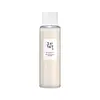What's inside
What's inside
 Key Ingredients
Key Ingredients

 Benefits
Benefits

 Concerns
Concerns

 Ingredients Side-by-side
Ingredients Side-by-side

Water
Skin ConditioningPolysorbate 20
EmulsifyingAloe Barbadensis Leaf Juice
Skin ConditioningGlycerin
HumectantSodium Gluconate
Skin ConditioningSodium Levulinate
Skin ConditioningLactococcus Ferment Lysate
Skin ConditioningCitric Acid
BufferingSodium Dehydroacetate
PreservativePanthenol
Skin ConditioningCentipeda Cunninghamii Extract
Skin ConditioningTasmannia Lanceolata Fruit/Leaf Extract
AntioxidantUndaria Pinnatifida Extract
Skin ConditioningPropanediol
SolventButylene Glycol
HumectantLactic Acid
BufferingSodium Benzoate
MaskingRhodosorus Marinus Extract
AntioxidantSodium Chloride
MaskingPotassium Sorbate
PreservativeDextran
Palmitoyl Tripeptide-8
Skin ConditioningWater, Polysorbate 20, Aloe Barbadensis Leaf Juice, Glycerin, Sodium Gluconate, Sodium Levulinate, Lactococcus Ferment Lysate, Citric Acid, Sodium Dehydroacetate, Panthenol, Centipeda Cunninghamii Extract, Tasmannia Lanceolata Fruit/Leaf Extract, Undaria Pinnatifida Extract, Propanediol, Butylene Glycol, Lactic Acid, Sodium Benzoate, Rhodosorus Marinus Extract, Sodium Chloride, Potassium Sorbate, Dextran, Palmitoyl Tripeptide-8
Water
Skin ConditioningMethylpropanediol
SolventPropanediol
Solvent1,2-Hexanediol
Skin ConditioningGlycerin
HumectantGlycereth-26
HumectantPolymethyl Methacrylate
Oryza Sativa Extract
AbsorbentCoptis Japonica Root Extract
Skin ConditioningUlmus Davidiana Root Extract
Skin ConditioningAmaranthus Caudatus Seed Extract
Skin ConditioningFicus Carica Fruit Extract
HumectantCentella Asiatica Extract
CleansingTheobroma Cacao Seed Extract
AntioxidantHydrogenated Lecithin
EmulsifyingSodium Hyaluronate
HumectantPanthenol
Skin ConditioningHydroxyethyl Urea
HumectantAluminum Chlorohydrate
AstringentButylene Glycol
HumectantMicrocrystalline Cellulose
AbsorbentSodium Citrate
BufferingKaolin
AbrasiveEthylhexylglycerin
Skin ConditioningDipotassium Glycyrrhizate
HumectantCitric Acid
BufferingDextrin
AbsorbentCeramide NP
Skin ConditioningTocopherol
AntioxidantRice Amino Acids
Skin ConditioningWater, Methylpropanediol, Propanediol, 1,2-Hexanediol, Glycerin, Glycereth-26, Polymethyl Methacrylate, Oryza Sativa Extract, Coptis Japonica Root Extract, Ulmus Davidiana Root Extract, Amaranthus Caudatus Seed Extract, Ficus Carica Fruit Extract, Centella Asiatica Extract, Theobroma Cacao Seed Extract, Hydrogenated Lecithin, Sodium Hyaluronate, Panthenol, Hydroxyethyl Urea, Aluminum Chlorohydrate, Butylene Glycol, Microcrystalline Cellulose, Sodium Citrate, Kaolin, Ethylhexylglycerin, Dipotassium Glycyrrhizate, Citric Acid, Dextrin, Ceramide NP, Tocopherol, Rice Amino Acids
 Reviews
Reviews

Ingredients Explained
These ingredients are found in both products.
Ingredients higher up in an ingredient list are typically present in a larger amount.
Butylene Glycol (or BG) is used within cosmetic products for a few different reasons:
Overall, Butylene Glycol is a safe and well-rounded ingredient that works well with other ingredients.
Though this ingredient works well with most skin types, some people with sensitive skin may experience a reaction such as allergic rashes, closed comedones, or itchiness.
Learn more about Butylene GlycolCitric Acid is an alpha hydroxy acid (AHA) naturally found in citrus fruits like oranges, lemons, and limes.
Like other AHAs, citric acid can exfoliate skin by breaking down the bonds that hold dead skin cells together. This helps reveal smoother and brighter skin underneath.
However, this exfoliating effect only happens at high concentrations (20%) which can be hard to find in cosmetic products.
Due to this, citric acid is usually included in small amounts as a pH adjuster. This helps keep products slightly more acidic and compatible with skin's natural pH.
In skincare formulas, citric acid can:
While it can provide some skin benefits, research shows lactic acid and glycolic acid are generally more effective and less irritating exfoliants.
Most citric acid used in skincare today is made by fermenting sugars (usually from molasses). This synthetic version is identical to the natural citrus form but easier to stabilize and use in formulations.
Read more about some other popular AHA's here:
Learn more about Citric AcidGlycerin is already naturally found in your skin. It helps moisturize and protect your skin.
A study from 2016 found glycerin to be more effective as a humectant than AHAs and hyaluronic acid.
As a humectant, it helps the skin stay hydrated by pulling moisture to your skin. The low molecular weight of glycerin allows it to pull moisture into the deeper layers of your skin.
Hydrated skin improves your skin barrier; Your skin barrier helps protect against irritants and bacteria.
Glycerin has also been found to have antimicrobial and antiviral properties. Due to these properties, glycerin is often used in wound and burn treatments.
In cosmetics, glycerin is usually derived from plants such as soybean or palm. However, it can also be sourced from animals, such as tallow or animal fat.
This ingredient is organic, colorless, odorless, and non-toxic.
Glycerin is the name for this ingredient in American English. British English uses Glycerol/Glycerine.
Learn more about GlycerinPanthenol is a common ingredient that helps hydrate and soothe the skin. It is found naturally in our skin and hair.
There are two forms of panthenol: D and L.
D-panthenol is also known as dexpanthenol. Most cosmetics use dexpanthenol or a mixture of D and L-panthenol.
Panthenol is famous due to its ability to go deeper into the skin's layers. Using this ingredient has numerous pros (and no cons):
Like hyaluronic acid, panthenol is a humectant. Humectants are able to bind and hold large amounts of water to keep skin hydrated.
This ingredient works well for wound healing. It works by increasing tissue in the wound and helps close open wounds.
Once oxidized, panthenol converts to pantothenic acid. Panthothenic acid is found in all living cells.
This ingredient is also referred to as pro-vitamin B5.
Learn more about PanthenolPropanediol is an all-star ingredient. It softens, hydrates, and smooths the skin.
It’s often used to:
Propanediol is not likely to cause sensitivity and considered safe to use. It is derived from corn or petroleum with a clear color and no scent.
Learn more about PropanediolWater. It's the most common cosmetic ingredient of all. You'll usually see it at the top of ingredient lists, meaning that it makes up the largest part of the product.
So why is it so popular? Water most often acts as a solvent - this means that it helps dissolve other ingredients into the formulation.
You'll also recognize water as that liquid we all need to stay alive. If you see this, drink a glass of water. Stay hydrated!
Learn more about Water